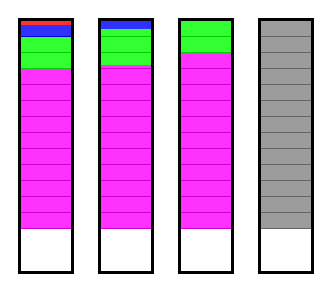[ The PC Guide | Systems and Components Reference Guide | Hard Disk Drives | Hard Disk Performance, Quality and Reliability | Redundant Arrays of Inexpensive Disks (RAID) | RAID Levels | Single RAID Levels ]
RAID Level 4
Common Name(s): RAID 4 (sometimes called RAID 3 by the confused).
Technique(s) Used: Block-level striping with dedicated parity.
Description: RAID 4 improves performance by striping data across many disks in blocks, and provides fault tolerance through a dedicated parity disk. This makes it in some ways the "middle sibling" in a family of close relatives, RAID levels 3, 4 and 5. It is like RAID 3 except that it uses blocks instead of bytes for striping, and like RAID 5 except that it uses dedicated parity instead of distributed parity. Going from byte to block striping improves random access performance compared to RAID 3, but the dedicated parity disk remains a bottleneck, especially for random write performance. Fault tolerance, format efficiency and many other attributes are the same as for RAID 3 and RAID 5.
|
This illustration shows how files of different sizes
are distributed between |
Controller Requirements: Generally requires a medium-to-high-end hardware RAID card.
Hard Disk Requirements: Minimum of three standard hard disks; maximum set by controller. Should be of identical size and type.
Array Capacity: (Size of Smallest Drive) * (Number of Drives - 1).
Storage Efficiency: If all drives are the same size, ( (Number of Drives - 1) / Number of Drives).
Fault Tolerance: Good. Can tolerate loss of one drive.
Availability: Very good. Hot sparing and automatic rebuild are usually supported..
Degradation and Rebuilding: Moderate degrading if a drive fails; potentially lengthy rebuilds.
Random Read Performance: Very good.
Random Write Performance: Poor to fair, due to parity calculation overhead and the bottleneck of the dedicated parity drive.
Sequential Read Performance: Good to very good.
Sequential Write Performance: Fair to good.
Cost: Moderate. A hardware controller is usually required, as well as at least three drives.
Special Considerations: Performance will depend to some extent upon the stripe size chosen.
Recommended Uses: Jack of all trades and master of none, RAID 4 is not as commonly used as RAID 3 and RAID 5, because it is in some ways a "compromise" between them that doesn't have a target market as well defined as either of those two levels. It is sometimes used by applications commonly seen using RAID 3 or RAID 5, running the gamut from databases and enterprise planning systems to serving large multimedia files.
![]() Next: RAID Level 5
Next: RAID Level 5
| The PC Guide
(http://www.PCGuide.com) Site Version: 2.2.0 - Version Date: April 17, 2001 © Copyright 1997-2004 Charles M. Kozierok. All Rights Reserved. |
Not responsible for any loss resulting from the use of this site. Please read the Site Guide before using this material. |
